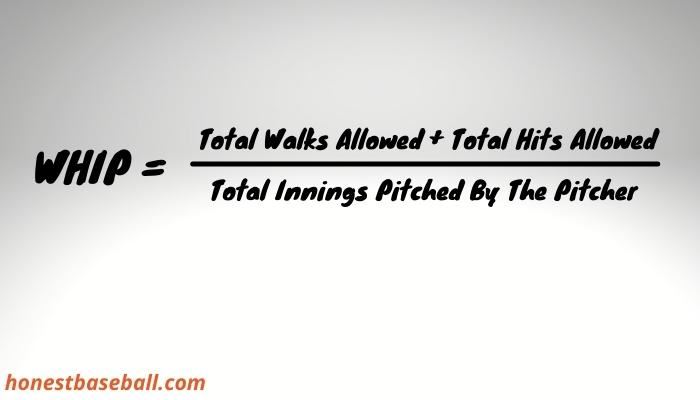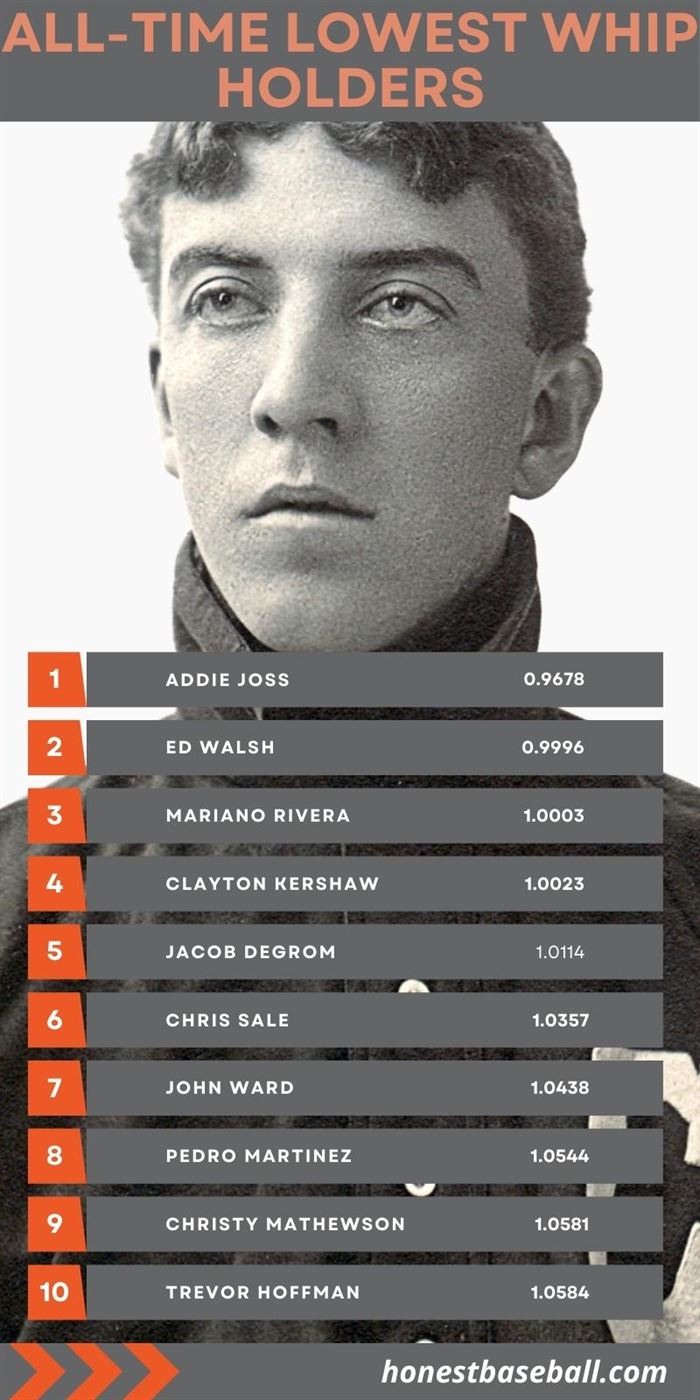You might always see WHIP along with the other performing data of a pitcher when he comes to pitch. What does WHIP mean in baseball, you think? You have a question about it in your mind, most probably.
Generally, baseball fans evaluate a pitcher’s performance with different analytical data and states.
However, WHIP is a statistic of a pitcher’s performance. It shows how good a pitcher is in pitching and preventing the batter from walking and hitting. And it is one of the most commonly used statistical data to evaluate the pitcher’s performance.
So, what about a detailed explanation of WHIP for the rest of the article? You will get a detailed explanation about WHIP when you finish reading the whole post.
What Does WHIP Mean In Baseball?

WHIP, which stands for Walks plus Hits per Innings Pitched, is a handy stat to check how well a pitcher is doing.
It basically tells us how many runners a pitcher lets on base in a single inning. When a pitcher has a lower WHIP, it’s usually a good sign because it means they’re keeping runners at bay.
To figure out WHIP, you just add up the walks (W) and hits (H) given up by the pitcher and then divide that total by the number of innings they’ve pitched (IP
Calculation Method Of WHIP In Baseball
WHIP calculation is a straightforward process if you have a clear understanding of what WHIP, walk, and hit are. Walk and hits are important to understand because they are correlated to WHIP.
However, there is no complexity in calculating WHIP. Also, you will not have to use any complex formulas.
The formula is easy, which is as follows.
WHIP = (Total Walks Allowed+ Total Hits Allowed)/Total Innings Pitched By The Pitcher

Let’s clear things up with an example.
Suppose a pitcher pitches a total of 90 innings in a season. By this time, he allowed 70 hits to the batters. On the other hand, batters also got 25 walks from his pitches.
In this case, the WHIP of the pitcher will be WHIP= (70+25)/90= 1.06.
I hope this would be feasible to understand for you. However, another fact about the WHIP is that it holds mostly four decimal places.
The following video might be useful to understand WHIP more.
What Is A Good WHIP In Baseball?
If you have read my earlier post on the ERA, you may already be aware that these sorts of statistics are useful when dealing with smaller numbers.
The lesser the number, the better it is for the pitchers, as the saying goes. There is no doubt that a small figure of WHIP is good. Though it’s not the final way to judge a pitcher, it is one of the most important entities to evaluate.
While there are certain WHIP metric ranges that can be specified with a rating, there are others that cannot.
“A WHIP of 1.5 or above is just a terrible statistic. On the other hand, a WHIP of 1.3 is considered average, while a WHIP of 1.10 is considered excellent. However, anything less than 1.00 is just fantastic.”
A pitcher with a WHIP of less than 1.00 is considered an outstanding pitcher, according to some.
If coaches or team management see a pitcher has a WHIP above 1.5, they will consider that as a bad stat of the pitcher. So they will not consider them for their team.
But, with a WHIP of around 1.30 for a pitcher, the team authorities might consider him to add to the team. And, if he has below 1.00 WHIP, there is no doubt that he will get the first preference by any team.
How to Measure a Pitcher with WHIP?

WHIP should not be used on its own but alongside other pitching stats like ERA (Earned Run Average) and SO (Strikeouts). This allows for a wholistic view of how effective a pitcher is.
Context is important when considering these statistics. Things like the quality of the opposing team’s hitters, the ballpark they’re in, and even the weather can all influence a pitcher’s WHIP.
Also, note that WHIP doesn’t account for the sequence of hits and walks. The order of these events can change how many runs are allowed by a pitcher.
Although a low WHIP is typically indicative of a good performance, it’s not everything. This stat doesn’t determine how valuable or skillful the pitcher is to their team.
Differences Between WHIP And ERA

The most significant distinction between the ERA and the WHIP is the entities and measurement types they use. The ERA is calculated using just one factor. Only earned runs are considered to calculate ERA.
Unearned runs that occur as a result of errors or passed balls, on the other hand, will not count toward the pitcher’s earned run average. The earned run, on the other hand, might be anything from a single baserunner to a home run.
The WHIP, on the other hand, is a measure of a pitcher’s performance that takes into account two separate factors. And it is being prepared to be taken before the attacking team scores their first point of the game.
WHIP is a statistic that only gauges the performance of pitchers. This is because a strong WHIP is designed to strike out the batter, yet the presence of a batter increases the likelihood of receiving a hit.
As a result, the WHIP is an ideal metric to use in evaluating a pitcher’s overall performance.
However, pitching velocity is a good entity to perform well in baseball when pitching. If you want to increase your pitching velocity, the article on how to increase pitching velocity by 10 mph may be helpful.
Is A Pitcher’s WHIP A Reliable Predictor Of Their Success?
Despite the fact that ERA is most often employed in measuring a pitcher’s overall performance in baseball, it is sometimes utilized in baseball specifically. A good WHIP, on the other hand, demonstrates the pitcher’s talent and performance more specifically.
The ability to pitch consistently well with good WHIP is always a sign of strong pitching, without question.
“A pitcher’s success is indicated by his WHIP since a good pitch allows for fewer hits by the hitters. The pitchers, on the other hand, are directly responsible for the walks that the hitters are given.”
As a result, better pitching results in a better WHIP statistic.
There are, however, a variety of cases to consider. Nolan Ryan, for example, was a fantastic pitcher but battled to maintain his WHIP. He did, however, finish with a higher WHIP.

From 1972 through 1978, on the other hand, he struck out an average of 300 batters every season. Despite the strikeouts, he also allowed walks every season, 170 batters on average.
Despite having a high number of walks, he allowed fewer hits, with an average of 6.3 hits per nine innings pitched. By combining the walks and hits, he was consistently in the middle of the average WHIP for his age.
You should know that he was the six-time leader of seven seasons throughout that period.
These sorts of instances are rare and extraordinary in their own right. By the way, with a low WHIP, statistics ensure the pitcher is good.
Pitchers With All-Time Best WHIP In Baseball History
If you search, you will find an average WHIP of around 1.30 in 2019, which was the team standard for that season. But you will be amazed that history holds some extremely insane pitchers, too. They hold WHIP below 1.10.
Addie Joss holds the lowest WHIP in baseball history.
Of the top 10 WHIP holders in baseball history, seven of them come from the National Baseball Hall of Fame.
On the other hand, among the other three pitchers, Clayton Kershaw retired last year. The Other two, Chris Sale and Jacob deGrom, are currently playing baseball.

Besides the all-time best, here are some important statistics of WHIP.
- Hilton Smith, a Kansas City Monarchs pitcher, was the single-season lowest WHIP holder. He was able to manage a 0.6176 WHIP in 1944 at the age of 37.
- John McMullin is the pitcher who faced the worst WHIP in a single season. He held 2.028 WHIP in 1871. In that season, he also allowed 153 earned runs, and 40 hits in his 249 innings pitched.
Do you know who are the 100 greatest baseball players in the history of baseball besides the WHIP holders? If you don’t, you can read our article on the 100 greatest baseball players in baseball history for reference.
Is There A Relationship Between Whip And Wins?
A team’s success is almost usually the result of a mix of strong performances. However, a team that benefits from the unique skill set of each player is also more likely to win.
A pitcher, on the other hand, is someone unique whose performance is always critical, in particular when the game is on the line.
According to the findings of the “Lahman Baseball Database,” there was a considerable association between a good WHIP and winning the game. In particular, the WHIP has a stronger association with winning than the ERA.
Another interesting fact is that the club that performs the best at the end of each season has the greatest WHIP figure of any other team.
Who Invented The WHIP Statistics?
WHIP is one of some sabermetrics that was able to get a place in baseball statistics. It is also one of the most common statistics in Fantasy Baseball.
However, Daniel Okrent, a former American writer, invented the WHIP statistic. However, he invented the statistic in 1979 in the Fantasy Baseball League. He was a part of the Fantasy Baseball League in 1979 and was looking forward to measuring the pitcher’s performance in a different way.
He began with the term “walks and hits per inning pitched” and then turned it into numerical values.
Frequently Asked Questions
Which Pitcher In Baseball History Holds The Lowest WHIP Record?
The lowest WHIP holder in history had a 0.9678 WHIP throughout the course of his career. It is Addies Joss who holds the all-time WHIP record. Whereas an average of 1.30 is good, he holds an average under 1. This is astonishing.
He accomplished this in his 2,327 innings of professional pitching.
Why is WHIP important in fantasy baseball?
WHIP is a critical metric in fantasy baseball as it helps assess a pitcher’s ability to prevent base runners, which is crucial in limiting runs scored and, thus, affecting the outcome of games.
What Is The Average Of WHIP In Major League Baseball?
The average of WHIP varies for the different seasons. As I mentioned before, the average WHIP in 2019 was around 1.3. More specifically, it was 1.34.
In 2018, the average league WHIP was 1.304, and in 2017, it was 1.342. At last, the WHIP of the year 2016 was 1.325.
Can WHIP predict a pitcher’s future performance?
WHIP can give an indication of a pitcher’s current effectiveness, but it’s not a definitive predictor of future performance
Wrapping Up
There are many confusing terms in baseball: DFA, ERA, FPS. If you are a baseball lover, you must want to know them all.
When it comes to baseball, statistics are always critical and significant for the players. Because it demonstrates the level of performance and quality of the players. Pitchers’ WHIP, on the other hand, is one of the most important performance measures.
It is due to the fact that each league has its own team development process. Managers, coaches, scouts, and other authorized employees make decisions on which athletes to sign based on their statistical performance.
The WHIP is one of the most important statistics that they looked at when choosing a pitcher.
More Resources
What Is The Strike Zone In Baseball
What Does TB Mean In Baseball?
What Is The Infield Fly Rule In Baseball?

Hello everyone. My name is Jason Butler, and I live in California, America. I was a professional AAA Minor League Baseball player. I lost my chance of playing MLB for injury issues, but I did not lose my love for baseball. I attended the coaching training program and am now working as a coach in a small school in San Diego.
I always love to share my experience and knowledge if that can help you. Play baseball, and stay fit.
